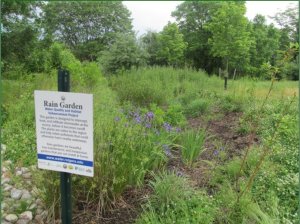Storm water runoff is water from rain and melting snow. It travels along gutters and flows over lawns, as well as driveways, parking lots and other impervious surfaces. It flows into storm drains and catch basins and through storm drain pipes and ditches. It eventually ends up in local waterbodies. It usually is not treated and along the way may pick up trash and toxins and other pollutants. This polluted storm water can kill fish and other wildlife, destroy wildlife habitat, contaminate drinking water sources and force the closing of beaches because of health threats to swimmers.
You can make a difference in your own backyard to help reduce storm water runoff and keep our waters clean with the installation of green infrastructure. This includes reducing impervious surfaces on your property, grading all areas away from your house at a gentle slope, i.e. diverting rain from paved surfaces onto the grass or rain gardens. Your goal should be to keep as much rainwater on site as possible.
Create a “healthy yard” and make a difference in reducing storm water runoff and keeping our waters clean by installing a rain garden or rain barrels on your property.
WHAT ARE RAIN GARDENS?
Rain gardens are plantings that are specifically designed to soak up rain water from roofs, from driveways, parking lots, and lawns. When it rains, the rain garden fills with a few inches of water and allows the water to slowly seep into ground filtering out pollutants such as fertilizer, pesticides, and oil, rather than having it run into the waterways or storm drains. This purifies the water and lets it replenish the aquifer rather than having it flow unfiltered into streams, lakes or the ocean. The ground should not remain wet, but should dry in a day or so of fair weather. It is planted with native shrubs and flowers that can tolerate wet or dry conditions and add to the beauty of the neighborhood and attract wildlife.
BUILD A RAIN GARDEN AT HOME
You can build your own rain garden at your home to collect water runoff and store it, permitting it to be filtered and slowly absorbed by the soil. The interception of water runoff from impervious surfaces will not only beautify your landscape but also act to minimize the volume and improve the quality of water entering conventional storm drains and nearby streams and minimize soil erosion. It will also help you provide a habitat for wildlife which can be sorely lacking in home gardens. And finally, the volume and quality of water is better whether it is absorbed in or leaves a rain garden.
RUTGERS UNIVERSTIY RAIN GARDEN INFORMATION CENTER
Rutgers University offers extensive training for landscapers, Master Gardeners, Environmental Stewards, Master Naturalists and community environmental groups who can then provide outreach to their communities. The Rutgers Rain Garden Manual is available here.
RAIN BARRELS
You can take an active role in reducing flooding and pollution in local waterways by installing rain barrels at your home. Install rain barrels under your gutter’s downspout to harvest rain water from your roof. Each rain barrel holds approximately 50 gallons. You can install them singly on hook them up in tandem to reserve even more water. Use the water to save money and save water when you irrigate your gardens with it during times of low rain. Rain barrels are for sale at local garden centers or are easily constructed from materials such as plastic garbage cans. If you are not so handy you can attend a rain barrel workshop that will save you money over purchasing ready made rain barrels. The Green Team offers periodic workshops to teach Ewing residents about important water conservation issues and how to construct and install rain barrels. Check out the website calendar for more information about upcoming trainings.
REDUCING IMPERVIOUS SURFACES
Reducing the amount of impervious surfaces in your yard allows water to be absorbed into the ground rather than becoming runoff that flows off of your property into the storm drains. You may also elect to install pervious pavement that allows for quick passage of water through the pavement to an underlying layer that allows storage until it is fully absorbed. Strategies include use of porous asphalt, pervious concrete, and interlocking pavers.
REPLACING LAWN WITH NATIVE PLANTINGS
Lawn grasses are very shallow rooted and do little to absorb heavy downfalls that create runoff. A strategy for dealing with this is to remove part or all of your lawn and replace it with native, deep-rooted, drought-resistant plants. This will also reduce much of the work required in lawn maintenance such as watering and mowing.

